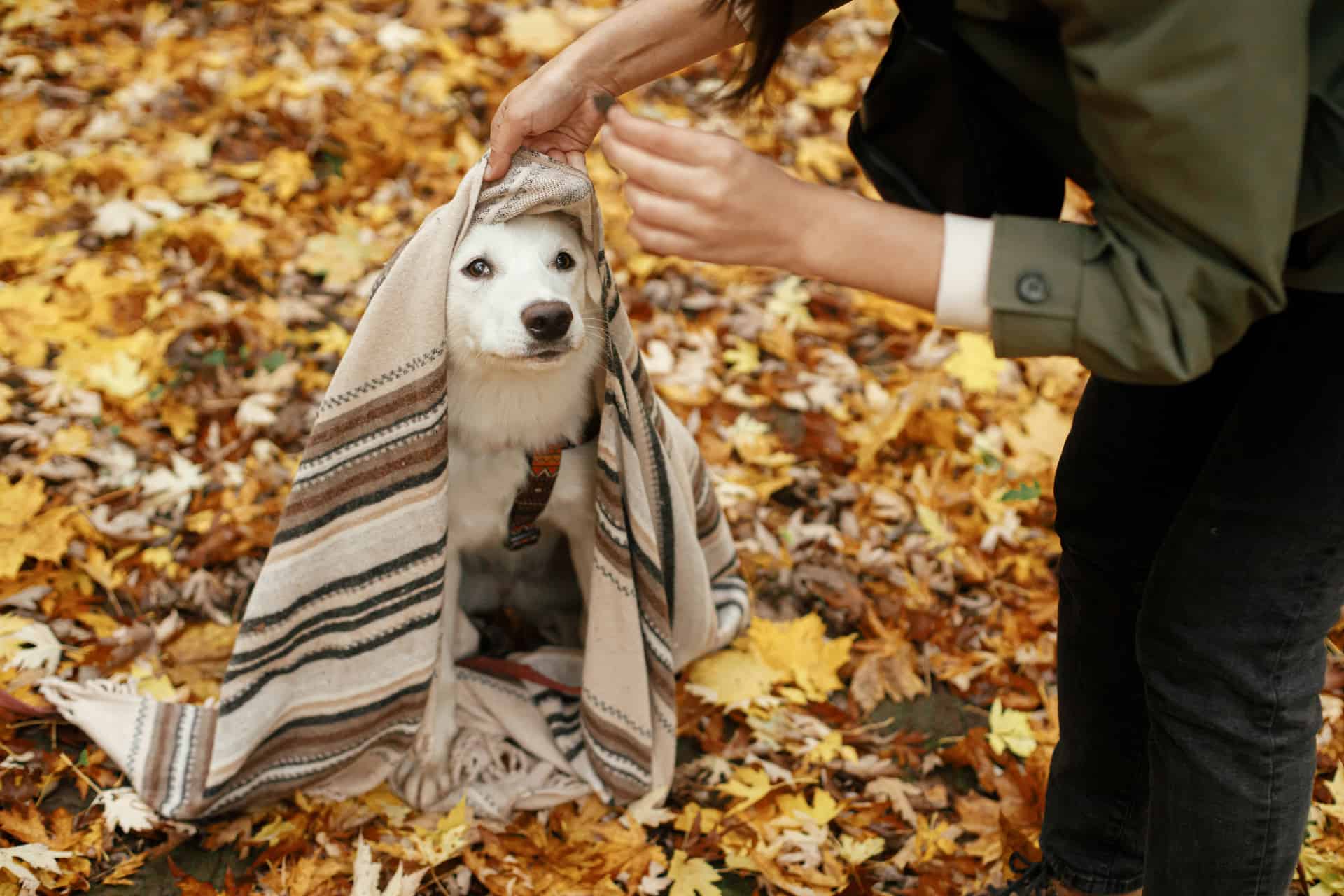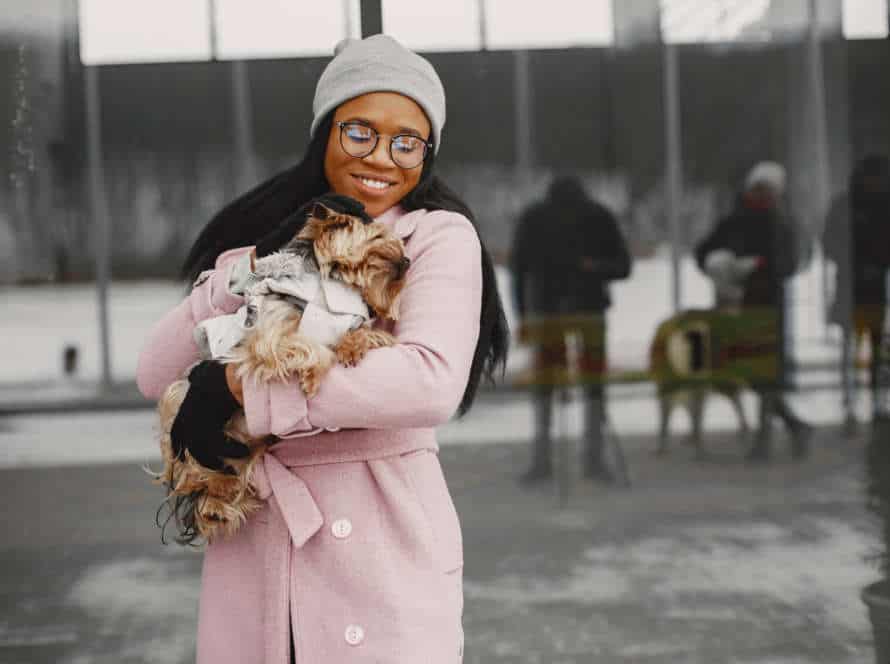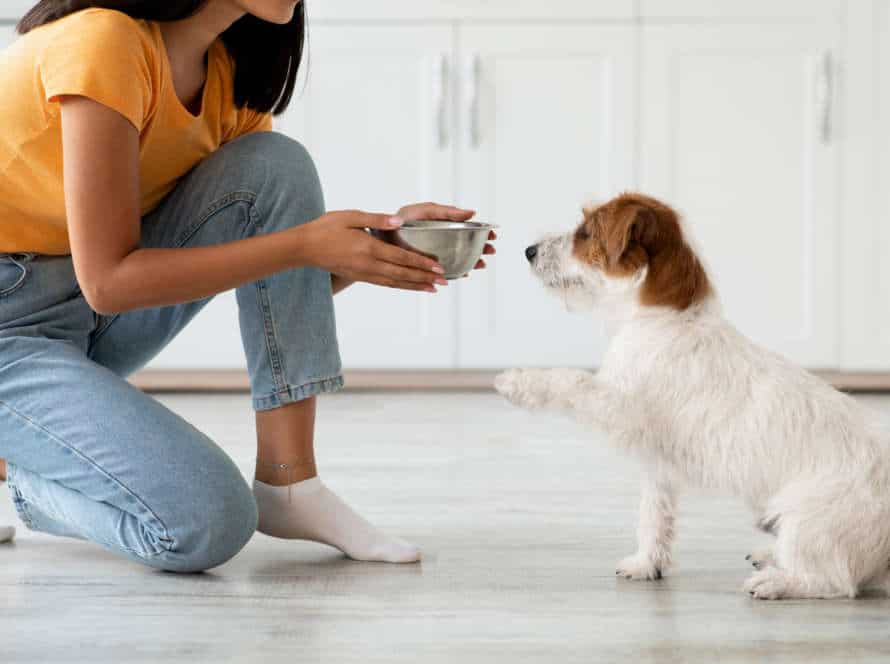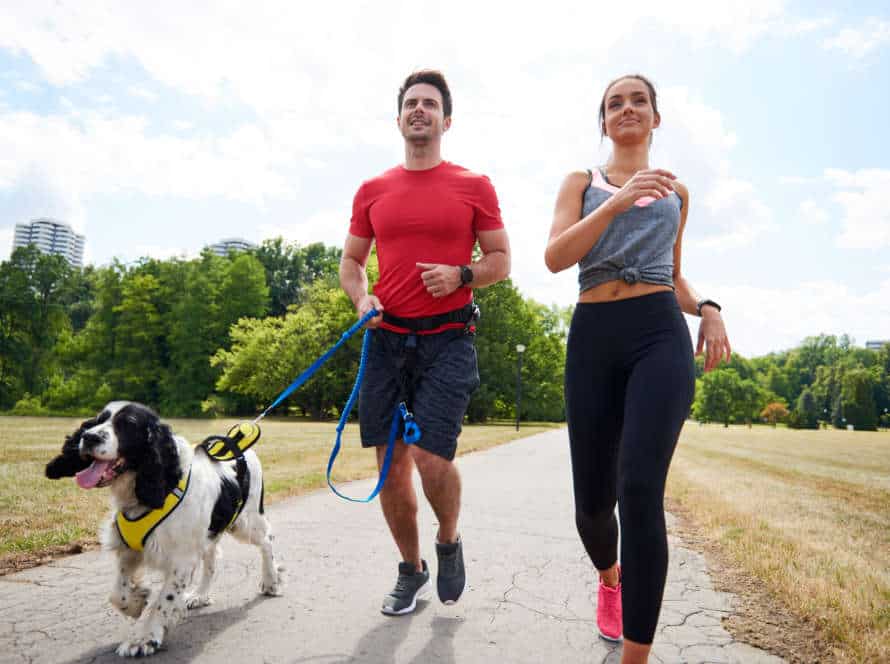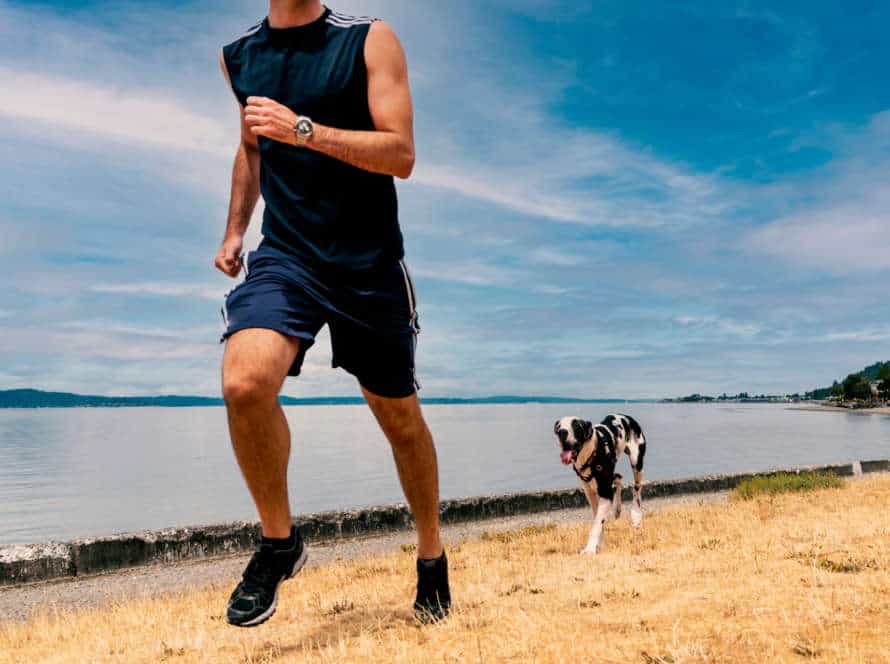The Science Behind Positive Reinforcement in Dog Training
Positive reinforcement is a scientifically-proven way to train dogs. It is based on the principles of operant conditioning.
When your pup does a good thing, like sitting or staying, reward him with a treat, praise, or playtime. This positive experience links the behavior to a reward. This makes your dog more likely to repeat the behavior.
Positive reinforcement has advantages. It is more effective long-term. It encourages better behavior and strengthens the bond between you and your pup.
Using positive reinforcement, you can teach your pup a range of things. From basic commands to complex tasks.
Pro tip: Be consistent and patient when using positive reinforcement. Your pup may take time to learn and repeat the desired behaviors. Offer lots of praise and rewards as you go.
Understanding Positive Reinforcement
Positive reinforcement is a type of dog training. It’s based upon rewarding good behaviour with treats, verbal praise or other rewards. This technique is one of the most effective and dependable ways for teaching pooches new habits. Comprehending the science behind this method can aid you in getting the most out of it for both you and your pup. Let’s delve into the science behind it now.
What is Positive Reinforcement?
Positive reinforcement is a training technique used with dogs. It rewards desirable behavior, instead of punishing undesirable behavior. The science behind it is easy to understand. Dogs will repeat behaviors that are rewarded, and avoid those that are not. This training method stops the dog from being exposed to harsh punishment, which can cause fear, anxiety, and aggression.
To use positive reinforcement, identify the behavior you want to promote. Offer a reward for it – be it praise, treats, or a toy. Over time, the dog will link the behavior with the reward, and will likely repeat it.
Pro tip: Consistency is key. Reward the dog every time it shows the desired behavior, no matter how small the step.
How Positive Reinforcement Works in Dog Training
Positive reinforcement is a great way to train your pup. It uses rewards to motivate and strengthen good behavior. Science supports this method, showing that what’s rewarded gets repeated, whilst punished or ignored behaviors won’t.
So, here’s the process:
- Pick the desired behavior. e.g. sitting or staying.
- Give a treat, toy or kind words when the behavior is done.
- Keep rewarding them till they get the hang of it. Then reduce the rewards.
Positive reinforcement is gentle, effective and a great way to bond with your pet. It builds trust and respect.
Benefits of Positive Reinforcement Dog Training
Positive reinforcement dog training is a humane way to teach pups. It focuses on rewarding nice behavior, not punishing bad. Benefits include:
- Building trust. This type of training encourages the dog to feel secure in its actions.
- Increased obedience. Rewards motivate dogs to obey commands.
- Reducing anxiety. A positive environment helps reduce stress.
- Developing confidence. Positive reinforcement boosts a pup’s self-esteem and helps them learn.
- Promoting bond. Rewarding good behaviors strengthens the connection between owner and pet.
Overall, positive reinforcement training is an effective and secure way to educate your pup.
Implementing Positive Reinforcement Techniques
Train your pup with positive reinforcement! Science has proven this to be a successful method. It encourages the behaviors you want your dog to repeat. Positive reinforcement is the most effectual way to train a dog. Let’s discuss how to put this into practice!
Reward-based Training
Reward-based training is a great way to teach desired behaviours to your dog without punishment or force. Science shows positive reinforcement works – a reward or treat when the dog does something good encourages them to do it again in the future.
Here are some tips for successful positive reinforcement training:
- Pick rewards your dog responds to – food, toys or praise.
- Give rewards quickly and often when they do something good.
- Don’t use punishment or negative reinforcement – it can hurt your pet and damage your relationship.
Positive reinforcement training helps your dog learn new behaviours and strengthens the bond between you. Pro Tip: Have patience and be consistent with it – results take time, but they’re worth it.
How to Choose an Effective Reward for your Dog
Choosing an effective reward for your pup is key for using positive reinforcement techniques in dog training. Let’s look at some pointers when picking a reward:
- Know your pup’s preferences. Watch to see what treats and toys they like the most and use ’em as a reward during training.
- Use high-value rewards for new behaviors. For instance, give small bits of cheese or chicken for new behaviors.
- Move to lower value rewards when your pup has mastered a behavior. Try commercial dog treats or verbal praise.
- Use variable reward schedules. Change the rewards and how often you give ’em to keep your pup motivated and prevent boredom.
By following these tips, you can effectively use positive reinforcement techniques to train your pup and strengthen your bond.
Timing and Consistency in Positive Reinforcement Training
Timing and consistency are vital for successful positive reinforcement dog training. Positive reinforcement is scientifically backed and involves rewarding good behavior to encourage it. Here’s how to make sure it works:
- Be timely! Rewards should be given straight away after the desired action. This will help the pup understand which specific behavior is being praised.
- Be consistent! Positive reinforcement should be used in each training session and by everyone who interacts with the dog. This prevents puzzlement and reinforces the behavior every time it happens.
Overall, positive reinforcement is a powerful training method that needs close attention to timing and consistency. With this method, you can teach your pup what you want while growing closer.
Common Mistakes in Positive Reinforcement Dog Training
Positive reinforcement is a great way to train your pup. But, mistakes can be made. Timing, pairing treats with behaviors, and too few or too many rewards can be detrimental to the training. Let’s get into it and talk about the science behind positive reinforcement and how to use it correctly.
Misunderstanding Reinforcement Schedules
Misunderstanding reinforcement schedules is a common mistake when it comes to positive reinforcement dog training. This is due to a lack of knowledge about the science behind it.
Reinforcement is the process of strengthening a dog’s behavior. Two types of reinforcement schedules exist:
- Continuous reinforcement: Each desired behavior from the dog is rewarded immediately.
- Intermittent reinforcement: Also known as partial reinforcement, only some of the time is a reward given. This makes the behavior more resistant to fading away.
Choose the right reinforcement schedule to get the desired behavior and to avoid frustration for both the trainer and the dog.
Understanding reinforcement schedules is key for successful positive reinforcement dog training.
Inconsistent Reinforcement
Inconsistent reinforcement is a common mistake in positive reinforcement dog training. This technique rewards desirable behavior to encourage repetition, however, inconsistent reinforcement can cause confusion in dogs. Resulting in undesired behavior.
The science behind this technique involves:
- Inconsistent timing – Delayed or inconsistent rewards make it hard for dogs to understand the reward relates to their behavior.
- Random treats – Treating a dog for something it hasn’t done or randomly, can reinforce bad behavior.
- Variation in rewards – Changing the type, amount or frequency of treats can also lead to confusion.
Understanding the science and consistently rewarding desirable behavior, while ignoring undesirable ones, can help improve the effectiveness of positive reinforcement dog training.
Lack of Patience and Persistence in Training
Training dogs takes patience, persistence and consistency. These are vital for positive reinforcement success. Not having these can lead to errors in positive reinforcement doggy training. It’s best to avoid some common mistakes:
- Commands and rewards should be the same each time.
- Accidentally rewarding bad behavior.
- Use friendly body language and tone while training.
- Don’t expect fast results and don’t get mad when they don’t happen.
To avoid these blunders, grasp the science of positive reinforcement in canine training. Repetition, staying the same and being patient are essential for forming new habits and molding behavior. Remember too, that pups learn at their own speed and making mistakes is part of the educational process.
Pro tip: Appreciate minor successes and stay upbeat during the training.
Positive Reinforcement for Basic Dog Behaviors
Positive reinforcement training is a favorite method for many pup owners. It’s based on the idea that if you reward the correct behavior, animals will keep doing it. To do this successfully, you need to understand the science and how to use it. So, let’s get into the basics of positive reinforcement for training dogs.
Potty Training using Positive Reinforcement
Positive reinforcement is great for potty training your pup! Building a strong bond of trust and understanding is key. Here are some tips:
- Take your dog out regularly, after meals and naps.
- Choose a spot for pottying, and take them there always.
- As soon as they go potty, reward them with treats, praise, and love.
- If accidents occur, clean up without scolding or punishing.
- Patience and consistency are essential with this training.
Positive reinforcement teaches dogs to associate good behavior with rewards like treats and praise. It’s based on behavioral psychology which says rewarding good is better than punishing bad.
Pro tip: Patience and consistency are a must. Setbacks are normal, and positive reinforcement takes time and effort.
Teaching Basic Commands through Positive Reinforcement
Positive reinforcement is a great way to teach your pup the basics. It encourages them to do the right thing, and it’s a great way to build a strong bond between you and your pup.
Here’s how to use positive reinforcement:
- Clicker training: Use a clicker to make a distinct sound. When your pup does something right, click and give a small treat or some positive attention.
- Treat training: Hold a treat in front of your pup and give a command like ‘sit’. Give the treat when they do it correctly.
- Verbal praise: Dogs love positive attention, so verbal praise is key. Use an excited and happy tone when they do something right.
With positive reinforcement, you’ll be able to teach your pup the basics quickly. Plus, you’ll be encouraging positive behaviors and making training a fun experience.
Positive Reinforcement for Reducing Negative Behaviors
Positive reinforcement is a great way to reduce bad behavior in dogs. Reward their good behavior and you can train them without using negative reinforcement or physical punishment.
Here are some behaviors that you can train with positive reinforcement:
- Sit: Hold a treat in front of the dog’s nose. Lift it slowly up and back. As they follow the treat, their bottom should lower to the ground. Give them the treat, praise and affection when they do this.
- Come: Use an inviting tone and exciting body language. When they come to you, reward them with a treat or praise and love.
- Stay: Start with a short amount of time and increase it bit by bit. When they stay in place, reward them with a treat or praise.
Using positive reinforcement encourages desirable behaviors. It’s more effective and humane than negative reinforcement or physical punishment. Pro Tip: Keep training sessions short, fun and positive. This way your dog stays motivated and engaged in learning.
Positive Reinforcement for Advanced Dog Behaviors
Positive reinforcement is a great tool for teaching advanced behaviors to your pup! It takes advantage of an animal’s natural behavior to seek out desired activities. These activities are then rewarded with treats or verbal praise. This reward-based way of training is popular, as it is easy and successful.
Here, we’ll explore the science behind positive reinforcement in dog training, and how to use it to teach complex behaviors.
Positive Reinforcement in Agility Training
Positive reinforcement is a great way to train your pup. It rewards them for good behavior, which is especially helpful in agility training. Here are some tips:
- Associate treats, toys, or verbal praise with the desired behavior.
- Identify the behavior and reward it immediately.
- Gradually reduce rewards and replace them with verbal prompts.
- Reward every correct behavior, even if it’s small.
- Keep training positive and fun, as dogs will respond best in a relaxed environment.
Positive Reinforcement in Guard Dog Training
Positive reinforcement is a great way to teach guard dogs! It’s proven by science to get results. Instead of punishing bad behaviors, you ignore or change them. Here’s how to use it:
- Treats and words of praise when they alert to strangers.
- Clicker training to help communication.
- Focus on good behaviors, not bad ones.
- Playtime and bonding to build trust.
- Be patient; it may take time for behaviors to stick.
Remember: Dogs are individuals and need a personalized approach. Get help from an expert if needed.
Positive Reinforcement in Service Dog Training
Positive reinforcement is a great way to train service dogs. Here’s why: rewards like treats, praise, and attention create a positive association in the dog’s mind. This reward becomes a motivator to repeat the behavior. Punishing a dog doesn’t teach them what to do instead.
Positive reinforcement is essential for service dog training. It helps the dogs make complex decisions, perform advanced behaviors, and be confident and happy in all different environments. Trainers can ensure their service dogs will be well-behaved with these techniques.
Frequently Asked Questions
Q: What is positive reinforcement in dog training?
A: Positive reinforcement is a training method that rewards desired behavior in dogs with treats, toys, or praise to encourage them to repeat the behavior in the future.
Q: How does positive reinforcement differ from punishment-based training?
A: Punishment-based training involves correcting unwanted behavior through the use of negative reinforcement, such as shouting or physical punishment. Positive reinforcement focuses on shaping behavior through positive rewards instead of punishment.
Q: Is positive reinforcement effective in training all dogs?
A: Yes, positive reinforcement can be effective in training all dogs, regardless of age or breed. Every dog responds differently to training, but positive reinforcement has been shown to be a reliable and humane training method for most dogs.
Q: Can positive reinforcement be used in conjunction with other training methods?
A: Yes, positive reinforcement can be used alongside other training methods, such as clicker training or crate training. However, it’s important to avoid punishment-based training methods as they can have negative effects on a dog’s behavior and trust in their owner.
Q: Can positive reinforcement be used to change undesired behavior?
A: Yes, positive reinforcement can be used to redirect or replace undesired behavior with desired behavior. For example, if a dog jumps on people, they can be taught to sit instead and rewarded with treats or praise.
Q: Is positive reinforcement only useful for training basic commands?
A: No, positive reinforcement can be used to teach a wide range of behaviors and skills, from basic commands like sit and stay to more complex actions like retrieving or agility training.

